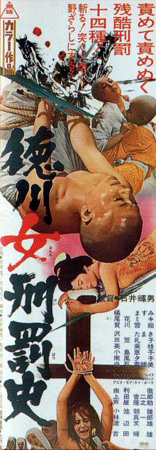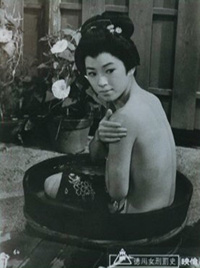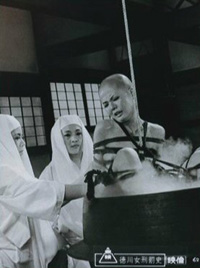Female Punishment of the Tokugawa, also known as Shogun’s Joy of Torture, is an anthology film and the first entry (although that's up for debate) in Teruo Ishii’s influential (for better or worse) Joys of Torture series. The film was one of the first to really mix  mounds of sex and nudity with extreme violence, and it pulled in a very large audience; so much so that a number of films followed in quick succession. The series is also often cited as the catalyst for the Pinky Violence genre, as its success showed studios just how much money could be made with films of this nature. Don’t be lured into thinking this is standard Pinky Violence fare though; you won’t be seeing women kicking much ass here. Instead, you’ll be forced to partake in many unspeakable acts done unto said women.
mounds of sex and nudity with extreme violence, and it pulled in a very large audience; so much so that a number of films followed in quick succession. The series is also often cited as the catalyst for the Pinky Violence genre, as its success showed studios just how much money could be made with films of this nature. Don’t be lured into thinking this is standard Pinky Violence fare though; you won’t be seeing women kicking much ass here. Instead, you’ll be forced to partake in many unspeakable acts done unto said women.
In the first story we meet a young girl named Mitsu, whose brother has just been injured in an unfortunate accident. Mitsu and her brother live a modest life, and don’t have the money to pay for a doctor. When Mino, a local Kimono shop owner gets wind of this, he kindly offers to pay for the medical bills, as long as Mitsu will offer her services to him. Once Mitsu’s brother finds out how they’re affording the doctor, he forbids Mitsu to go to Mino, insisting he’ll find a way to pay. Mitsu goes anyway, in fear of retaliation. Upon finding this out, Mitsu’s brother professes his love for her, and they spark up an incestuous relationship. This is something strictly forbidden, and when Mino finds out, the consequences will be dire.
The next story takes place at a convent, where both nuns and priests reside, yet are strictly forbidden to come into contact with one another. A new Mother Superior, named Reiho, has arrived to take over the nun’s convent, along with her servant, Rintoku. The two have a bit more than just a working relationship; they’re lovers. Reiho has never known the touch of a man, and when she spies one of the priests, Shunkai, her interest is aroused. Rintoku notices a change in Reiho’s demeanor and brings it up, but Reiho vows to never act on her desires. The next day, Reiho stumbles on Shunkai involved in a sexual act with a fellow sister, Myoshin. Reiho calls Shunkai out on it, and he begs for her not to report on Myoshin’s involvement. Reiho forces him to pray under a waterfall, to wash away all desire for sex. To test this, and to appease her own carnality, Reiho goes into the water and seduces Shunkai. Once the act is done, Shunkai rejects her, and tells her he only did it to absolve Myoshin. This creates a rage in Reiho, and along with a number of her other sisters, they torture Myoshin in various despicable ways. A number of the sisters are appalled when they hear of this, and Reiho’s reign of terror is about to come back and haunt her.
The final story deals with a man named Horicho, who is the most famous tattooist in Edo, and specializes in Irezumi that depict various scenes of aguish. Upon finishing work on a local geisha girl, the entire town is enthralled with his work; that is until Lord Nambara criticizes it, telling Horicho that the pain in the face of the woman in the tattoo is all wrong. Disparaged, Horicho begins looking for a new woman to work on. When he finds the perfect subject, she refuses him, and he ends up drugging her and taking her back to his place. While there, he tattoos her private area, shaming her and forcing her to become his servant. Not wanting to get the facial features wrong this time, Horicho begs Lord Nambara to take him along to Nagasaki so he can watch him torture criminals, which are unsuspecting Christian missionaries from Russia. The women are barbarically tortured, and Horicho captures the agony perfectly. But he’s having one problem: he can’t seem to capture the face of the torturers. Horicho has a plan all his own on how to get that just right…
The opening scene of Female Punishment of the Tokugawa really sets the tone for the entire film. While it has no bearing on the main three stories, the film opens with a  hanging woman being sliced in half and decapitated, a burning at the stake, and a grisly little ditty featuring a woman being ripped in two by running oxen. There should be no doubts after these opening minutes about what you’re in store for, and any that are turned off by it should cut their loses early. While the gore factor after the opening is toned down, the unthinkable atrocities done to countless women aren’t. Yes, the film is highly misogynistic, with a cast of women that for the most part come off as weak and helpless, but it’s certainly a product of the era in which it was produced. Producers wanted people back in the theatre, and with the reigns on censorship loosening, giving the audience something extreme that they had never seen before was exactly the way to do it.
hanging woman being sliced in half and decapitated, a burning at the stake, and a grisly little ditty featuring a woman being ripped in two by running oxen. There should be no doubts after these opening minutes about what you’re in store for, and any that are turned off by it should cut their loses early. While the gore factor after the opening is toned down, the unthinkable atrocities done to countless women aren’t. Yes, the film is highly misogynistic, with a cast of women that for the most part come off as weak and helpless, but it’s certainly a product of the era in which it was produced. Producers wanted people back in the theatre, and with the reigns on censorship loosening, giving the audience something extreme that they had never seen before was exactly the way to do it.
One of the very strange appeals with films like these are the production values. Just like the Pinky Violence films it spawned, and really most Japanese exploitation films of the era, the film looks nearly identical to its mainstream counterparts. These films were not independent; they were produced by big studios, with decent budgets. Female Punishment of the Tokugawa, and every other film in the Joys of Torture series, was produced by Toei Studios, the same studio responsible for films such as Kinji Fukusaku’s Battles Without Honor and Humanity series and many of Sonny Chiba’s most memorable films. The studios were all about whether something made money, and content was of little concern to them.
As for the stories and the film itself, it’s a mixed bag. After the aforementioned opening sequence, the opening story that deals with the brother-sister relationship is surprisingly tame in contrast. Yes, there is that little matter of incest, but the segment is mostly an emotional one, with little bloodshed or exploitive sex. It is quite bleak, but I found it to be very competent overall. The middle section is the films weakest point; the story is dry, and the torture scenes are uninteresting. When compared to classic Nunsploitation like Flavia the Heretic and School of the Holy Beast, it fails on all levels, although it closes on a high note.
The highlight of the film is the utterly insane final act, which easily makes up for the lack of debauchery in the first segment. It’s filled to the brim with a copious amount of nudity, blood, and torture, some of which is quite extreme.  We have women kneeling on razors while rock slabs are stacked on them, women being burned and whipped, dunked in water, and stretched on the rack. The villain of the piece, Lord Nambara, is especially twisted and depraved.
We have women kneeling on razors while rock slabs are stacked on them, women being burned and whipped, dunked in water, and stretched on the rack. The villain of the piece, Lord Nambara, is especially twisted and depraved.
The Nambara character is also the storyline constant throughout the film; yes, there’s more than just the torture that binds the segments together. When the women need punishing, he’s the one that arrives on the scene. In contrast, he’s accompanied by another government official, who actually provides commentary between segments. The man is much less enthusiastic about Nambara’s tactics; he seems to have a kind heart, but is obviously lower in rank, and is thus forced to go along with the prescribed methods.
Oddly enough, while there’s no question that for the most part Ishii made the film to shock, the film actually deals with some decent moral dilemmas, and has a better constructed story than many films whose main goal is to stir up controversy through taboo elements. I was quite impressed when the film came to a conclusion that was, dare I say, upbeat. As downtrodden as much of the film is, it ends in a fashion I didn’t expect, and proves that Ishii still wanted the film to have some merit, and wanted to elevate it above just pure schlock.
Female Punishment of the Tokugawa is a film recommended to two types of people: the adventurous, and those that enjoy seeing the history of film. While far from a masterpiece, it is notable for ushering in a new era of Japanese cinema, and laid the groundwork for Pinky Violence and violent exploitation films in general. While things certainly got better, if you’re a fan of this style of film, you definitely owe it to yourself to see where much of it began.
Please feel free to discuss "Female Punishment of the Tokugawa" here, in our forums!

